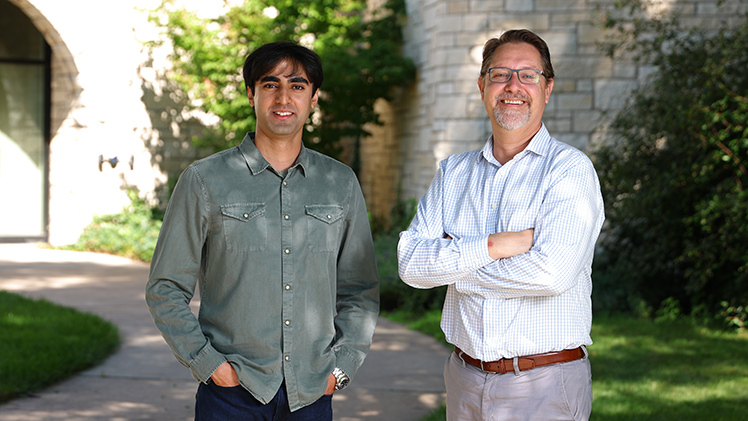Astronomers made headlines this spring with the announcement of the strongest-yet indication of extraterrestrial life on a planet far beyond our solar system.
But the claim based on a molecule in the planet’s atmosphere that could have been created by living organisms quickly drew scrutiny — along with widespread attention to the shortcomings of the methods that astronomers use to analyze far-distant objects.

Harshil Kothari, a doctoral student studying physics with a concentration in astrophysics, is leading a research project through the Future Investigators in NASA Earth and Space Science and Technology (FINESST) Program.
Enter The University of Toledo’s Harshil Kothari, a doctoral student studying physics with a concentration in astrophysics.
Kothari aims to study and improve these atmospheric retrieval techniques, which infer the atmospheric composition of a planet from observations of the light emitted by the planet, through the Future Investigators in NASA Earth and Space Science and Technology (FINESST) Program. He recently learned that his proposal was one of just 5% accepted in the astrophysics division in the latest program cycle.
NASA is funding his two-year project with $100,000.
“I’m very excited,” Kothari said. “Because this program is so competitive, it confirms that the science we’re trying to do is good and necessary.”
The NASA FINESST Program supports graduate student-designed-and-performed research projects that advance NASA’s Science Mission Directorate. In his proposal with Dr. Michael Cushing, his advisor and a professor of in the Department of Physics and Astronomy, Kothari lays out his plan to improve atmospheric retrieval techniques by digging into data that astronomers have gathered about brown dwarfs using the new James Webb Space Telescope.
Brown dwarfs are starlike objects with too little mass to sustain nuclear fusion. Kothari is interested in analyzing them as a means to learn how to better interpret data about planets that orbit stars other than our sun.
“The study of exoplanets has become a major focus of astronomers, and yet the models used to interpret exoplanet observations are plagued by systematic errors and biases,” Cushing said. “Harshil will identify ways to mitigate many of these biases by exercising these models on Webb observations of brown dwarfs because their atmospheres are so similar to those of exoplanets.”
Kothari followed a childhood fascination with the cosmos to an undergraduate program in astrophysics and applied mathematics at Ohio University. In choosing to continue his studies at UToledo’s Ritter Astrophysical Research Center, Kothari, originally of India, said he liked the idea of staying in the Buckeye State.
He also was impressed by the opportunities at UToledo, which at the time had just learned that its faculty and student astronomers would be among the first to access data out of Webb. UToledo ranked No. 6 among worldwide institutions in successful proposals for the first cycle of scheduled observing time on the telescope in 2021, with projects led by four faculty astronomers and one doctoral student making the cut.
One of those faculty astronomers was Cushing, an expert in brown dwarfs, with whom Kothari connected once at UToledo. Kothari began working with Cushing to model atmospheres of brown dwarfs using the data that came out of his first-cycle project.

Harshil Kothari, left, a doctoral student studying physics with a concentration in astrophysics, works closely with Dr. Michael Cushing, his advisor and a professor in the Department of Physics and Astronomy.
With its advanced capabilities at near-infrared and mid-infrared wavelengths, the new space telescope was proving groundbreaking for the study of brown dwarfs. It was significantly expanding and improving our existing datasets on these bodies.
But Cushing and Kothari quickly realized that this new dataset wasn’t working well with the usual atmospheric retrieval techniques.
“We had gained so much information that wasn’t previously accessible to us,” Kothari said. “It was becoming clear that our models weren’t completely accurate, and so the way we were trying to interpret them wasn’t completely accurate. When we started doing some tests, we saw that this method has some flaws in it.”
A key example outside the scope of their research? That widely discussed announcement about a possible signature of life on the planet K2-18b in April.
Subsequent analyses have suggested alternative origins of the molecule at question, or even a misinterpretation of the data, pulling the punch out of earlier headlines about extraterrestrial life.
“The goal of my research is to get more reliable results from atmospheric retrievals,” Kothari said. “This is important because retrievals are one of the primary methods that we use to analyze the atmospheres of planets, exoplanets and brown dwarfs. A lot of the astronomical community uses this method, so it needs to be improved.”
Kothari is well suited to the challenge, Cushing said.
“From the moment I began working with Harshil, he showed a remarkable ability to dig into a problem and find a solution,” Cushing said. “The models used to study exoplanet atmospheres are complex, requiring an understanding of physics, statistics and multiple programming languages. In only a few years, Harshil has gained a national reputation as an expert in using these models, and this FINESST award further underscores the importance of his work.”